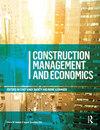Regional differences and heterogeneity of construction and demolition waste with economic growth: evidence from China
IF 3.3
Q2 BUSINESS
引用次数: 3
Abstract
Abstract The reduction of construction and demolition waste (C&DW) has a significant impact on the sustainable development of the construction industry. Differentiated reduction management policy is the key to C&DW reduction management. Based on the calculation of C&DW generation, this paper studies the temporal and spatial evolution characteristics, heterogeneity of C&DW with economic growth, and driving factors of C&DW generation in 30 provinces from 2007 to 2018 by using the methods of standard deviation ellipse model, environmental Kuznets curve (EKC) and geographic detector. The results show that the C&DW generation in China shows an increasing trend, “low in the west, and high in the East” and “high in the South and low in the north,” with significant regional differences. The temporal and spatial distribution of C&DW generation shows a “northeast southwest” trend, and this pattern has a trend of changing to “due north - due south”; C&DW generation increases with the economic growth, and the proportion of “inverted N” provinces is large, which is in the stage of continuous increase in the C&DW generation; The economic output effect of construction industry is the most important factor affecting the spatial distribution of C&DW generation. The impact of C&DW generation in each province has shifted from the single core driving effect of economy to the common guidance of economy and environmental protection. The interaction of different factors has a greater impact on the spatial distribution of C&DW generation than that of each factor alone.建筑垃圾与经济增长的区域差异和异质性:来自中国的证据
摘要建筑拆除垃圾的减少对建筑业的可持续发展有着重要的影响。差别化减量化管理政策是减量化管理的关键。在计算城乡建设用水量的基础上,采用标准差椭圆模型、环境库兹涅茨曲线(EKC)和地理探测器等方法,研究了2007 - 2018年中国30个省区城乡建设用水量的时空演变特征、随经济增长的异质性及其驱动因素。结果表明:中国的大气污染和大气污染总量呈现“西低东高”和“南高北低”的增加趋势,且区域差异显著;时空分布呈现“东北-西南”趋势,并有向“正北-正南”转变的趋势;工耗发电量随经济增长而增加,且“倒N”省份占比较大,处于工耗发电量持续增加的阶段;建筑业的经济产出效应是影响城乡建筑工耗空间分布的最重要因素。各省水兵发电的影响已经从单一的经济核心驱动作用转向经济与环境保护的共同引导作用。不同因子的交互作用对C&DW生成空间分布的影响大于单个因子。
本文章由计算机程序翻译,如有差异,请以英文原文为准。
求助全文
约1分钟内获得全文
求助全文
来源期刊

Construction Management and Economics
BUSINESS-
CiteScore
7.50
自引率
14.70%
发文量
58
期刊介绍:
Construction Management and Economics publishes high-quality original research concerning the management and economics of activity in the construction industry. Our concern is the production of the built environment. We seek to extend the concept of construction beyond on-site production to include a wide range of value-adding activities and involving coalitions of multiple actors, including clients and users, that evolve over time. We embrace the entire range of construction services provided by the architecture/engineering/construction sector, including design, procurement and through-life management. We welcome papers that demonstrate how the range of diverse academic and professional disciplines enable robust and novel theoretical, methodological and/or empirical insights into the world of construction. Ultimately, our aim is to inform and advance academic debates in the various disciplines that converge on the construction sector as a topic of research. While we expect papers to have strong theoretical positioning, we also seek contributions that offer critical, reflexive accounts on practice. Construction Management & Economics now publishes the following article types: -Research Papers -Notes - offering a comment on a previously published paper or report a new idea, empirical finding or approach. -Book Reviews -Letters - terse, scholarly comments on any aspect of interest to our readership. Commentaries -Obituaries - welcome in relation to significant figures in our field.
 求助内容:
求助内容: 应助结果提醒方式:
应助结果提醒方式:


